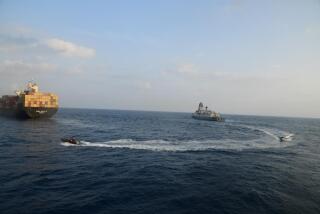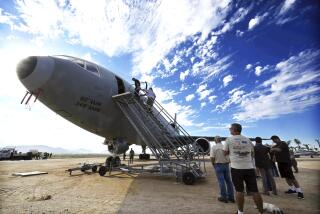Jet Hijacking Suspect Seized at Sea by FBI
- Share via
WASHINGTON — A suspected Lebanese terrorist accused of hijacking and blowing up a jetliner more than two years ago in Beirut was captured by FBI agents in the Mediterranean Sea and flown to the United States on Thursday to stand trial in Washington, the Justice Department announced.
The suspect, Fawaz Younis, 28, who appeared before a U.S. magistrate here late Thursday, was the first foreign terrorist suspect arrested abroad and brought to the United States under anti-terrorist laws that Congress enacted in 1984 and 1986 after a spate of attacks on Americans in the Middle East, Europe and Latin America.
Younis appeared at a brief pretrial hearing before U.S. Magistrate Jean Dwyer late Thursday. He is charged in a federal indictment with conspiracy, hostage-taking and destruction of an aircraft, a Jordanian plane on which four Americans were passengers.
When asked through an interpreter if he could afford an attorney, the dark-haired and bearded suspect bowed his head and said in Arabic: “No, I cannot.”
A court-appointed lawyer said Younis would plead not guilty, and another hearing was scheduled for next Tuesday. He was ordered held without bond.
Younis’ arrest immediately raised concerns among experts on political violence that Lebanese radicals in the Shia Muslim community might retaliate by targeting Americans in the Middle East or Europe for new terrorist attacks.
But Justice Department officials have said previously they would not let the threat of terrorism deter their aggressiveness in pursuing and prosecuting suspected terrorists, and Atty. Gen. Edwin Meese III said at a news conference Thursday that Younis’ arrest was “the first such operation, but it will certainly not be the last.”
Neither Meese nor other senior officials at the Justice Department or the FBI would provide any details of Younis’ capture last Sunday other than to say he was transferred after his arrest to the U.S. aircraft carrier Saratoga in the north central Mediterranean near the island of Corsica, where it was taking part in a NATO exercise.
Younis was flown on a U.S. military aircraft to Andrews Air Force Base outside Washington without touching down in any foreign country, officials said.
‘International Waters’
Meese would say only that the arrest was made “in international waters in the Mediterranean” without the assistance of any other nation. “I want to emphasize that this was a law enforcement operation,” the attorney general told reporters.
Another official said: “This is a very sensitive case, and obviously this was a very effective operation. We used boats in international waters and we used the Defense Department for logistical support. It was an ongoing matter for many weeks.
“But we will not disclose the techniques and manner of the apprehension because we obviously hope to use these tactics successfully in the future.”
Under the new anti-terrorism legislation, known as “long arm” statutes, Meese said, “The United States has the authority to investigate and prosecute individuals suspected of committing specific types of offenses under U.S. law in foreign jurisdictions. And we intend to use that authority wherever and whenever circumstances permit.”
If convicted, Younis could face life imprisonment. He could have received the death penalty if any Americans had been killed, officials said. However, the U.S. indictment said all the passengers on the hijacked flight were released unharmed except for several Jordanian sky marshals, who were severely beaten.
“It is a major policy goal of the United States government that we bring to justice those who are accused of being responsible for terrorist crimes,” Meese said. “As President Reagan has said, terrorists throughout the world must know that ‘they can run but they can’t hide.’ ”
The hijacking occurred June 11, 1985, when five young gunmen, all believed to be Lebanese Shia Muslims, stormed a Boeing 727 belonging to Alia, the Jordanian national airline, at Beirut International Airport. The plane, carrying a crew of nine and 64 passengers, including four Americans and six Jordanian sky marshals, was commandeered and flown to Tunisia, Cyprus and Sicily before returning to Beirut.
In a rambling statement, the hijackers identified themselves as members of the Brigade of the Marches of Lebanese Resistance and demanded that all Palestinian fighters be withdrawn from Lebanon and distributed to other Arab countries. They demanded also that Arab League Secretary General Chadli Klibi come to Beirut to hear their grievances.
At the time of the hijacking, Shia Muslims from the Amal movement had been battling for three weeks with hundreds of Palestinians besieged in three refugee settlements near the airport, Burj al Brajneh, Sabra and Chatilla. The hijackers apparently were angered by an Arab League resolution calling for a cease-fire in the intra-Arab fighting and for the withdrawal of Amal from the Palestinian camps.
Justice Department officials said Younis, who lived in Beirut, was a member of Amal and identified him as “Nazeeh”--the alias used by the hijackers’ spokesmen during the crisis.
The hijackers had threatened to kill the passengers if their demands were not met. When none of the demands were met 28 hours after the seizure, and several deadlines had passed, the hijackers freed the passengers, crew and sky marshals, wired the cockpit with dynamite and blew up the aircraft. Private radio stations in Beirut said the gunmen escaped and disappeared into the Shia-controlled territory around the airport.
The Swedish captain of the plane, Ulf Sultan, later told reporters that the hijackers were “young men who believe very much in their cause . . . . They were like a little army, each one fully equipped with dynamite, hand grenades and plastic explosives.”
Two of the Americans released from the Alia Flight 402--Landry T. Slade, a professor at the American University at Beirut, and his 16-year-old son, William--boarded a Middle East Airlines flight to Cyprus a few hours later.
But that flight also was hijacked, this time by a Palestinian protesting the Shias’ earlier hijacking. The passengers were released unharmed in Cyprus, where the gunman apparently was allowed by Cypriot authorities to slip out of the country.
More to Read
Sign up for Essential California
The most important California stories and recommendations in your inbox every morning.
You may occasionally receive promotional content from the Los Angeles Times.










